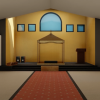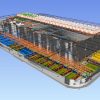Client Summary
Project Name: Georgetown University 3D Laser Scanning
- Location: Washington, DC
- Project Area: 407,263 sq. ft.
Scope of Work:
- Scan existing interior spaces.
- Perimeter walls with facade connections
- Columns
- Ceiling conditions
- MEP Shafts (8 floors, 1 penthouse, and 4 below-grade levels; total 13 floors)
Trades Covered: Architectural Engineering Services
Software Used:
- 3D Laser Scanning: RTC 360
- Data Optimization: Cyclone Registration 360
Delivered Data Formats: RCP, E57, LGS
Project Specialty:
- Unique Feature: Scanning of the 13-story MEP Shaft
Level of Building: 13
Number of people working: 1
Project Status: Ongoing
Client name: Whiting Turner
Project Description: The Georgetown University 3D Laser Scanning project involved scanning the interior spaces, perimeter walls with facade connections, columns, ceilings, and MEP shafts of a large-scale building complex spanning 13 floors.
The project area encompasses 407,263 square feet of space. The scope of work includes utilizing advanced scanning technology, specifically the RTC 360 scanner, to capture detailed as-built conditions for architectural and engineering services.
The data is then optimized using Cyclone Registration 360 software to ensure accuracy and efficiency in processing. The project focuses on delivering data in RCP, E57, and LGS formats, facilitating seamless integration into design and construction workflows.
Challenges:
- The scale and complexity of the building, including the 13-story MEP shaft, present challenges in capturing detailed as-built conditions accurately.
- Coordination and collaboration among various stakeholders are crucial to ensuring comprehensive scanning coverage and data accuracy across all floors and components.
Resolution Strategies:
- Utilization of advanced scanning equipment and software, such as the RTC 360 scanner and Cyclone Registration 360, for precise data capture and optimization.
- Implementation of meticulous scanning protocols and quality control measures to address challenges related to building scale and complexity.
- Continuous communication and coordination with the client, Whiting Turner, to ensure project objectives are met effectively and efficiently.
Conclusion:
The Georgetown University 3D Laser Scanning project represents a significant endeavor in capturing the detailed as-built conditions of a large-scale building complex.
By leveraging advanced scanning technology and software, the project aims to deliver accurate and comprehensive data that supports architectural and engineering services for future design and renovation initiatives.
With ongoing collaboration and coordination, the project team endeavors to achieve successful outcomes in meeting client requirements and project objectives.
Description
Contact us today for customized BIM services
Category: 3D LASER SCANNING, COMMERCIAL









